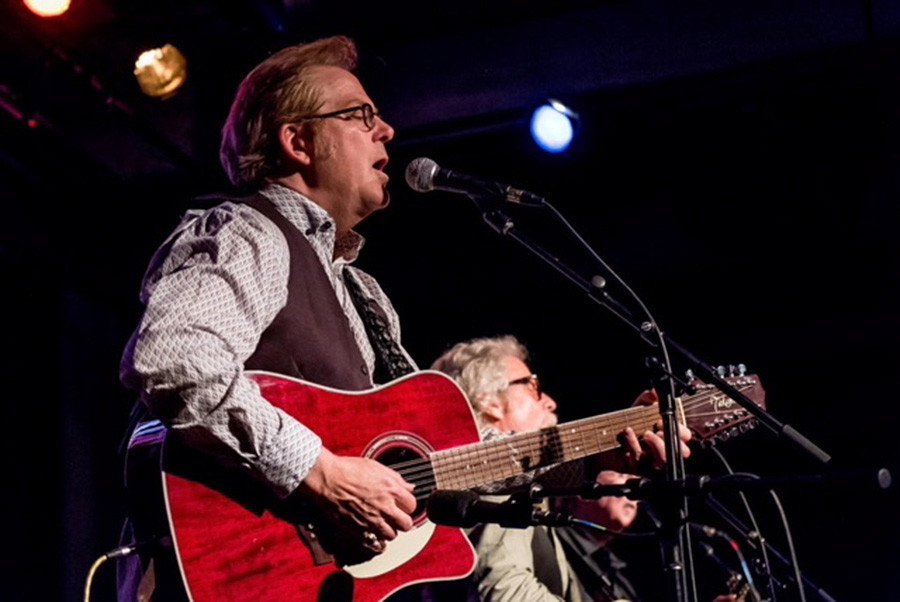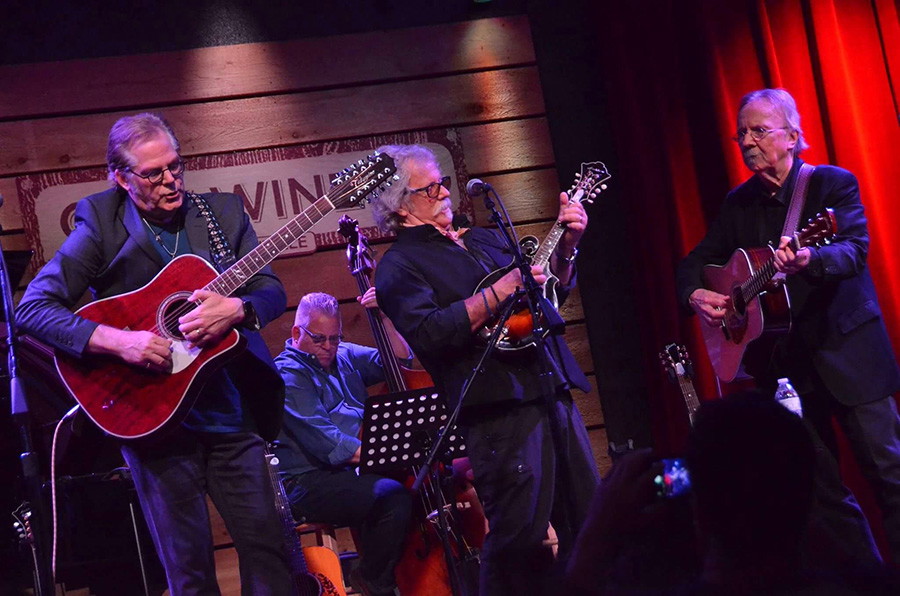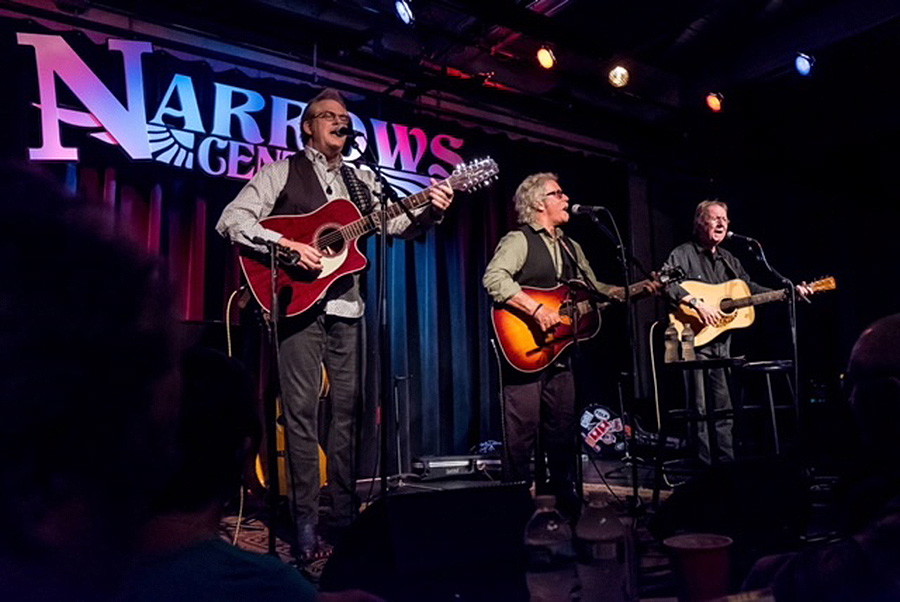Artist Spotlight: John Jorgenson
Artist Spotlight: John Jorgenson


We began our chat with one of the world’s most respected and acclaimed guitar players, Takamine Signature artist John Jorgenson, by making sure his Ventura, CA-based home wasn’t affected by the recent wildfires we’ve experienced in Southern California. “It was actually last year’s fires that forced us to evacuate at the time. This year, we only dealt with smoke and ash.” John’s guitar playing, be it in his J2B2 bluegrass band, his namesake gypsy jazz quintet, his time playing with the Hellecasters, or as a sideman to artists like Bonnie Raitt, Elton John, Luciano Pavarotti, and Bob Dylan, always has a fiery element to it.
Do you recall when you first became aware of Takamine?
Probably the first time I saw Takamine was when some really accurate copies of Martin guitars came in the ‘70s into my local music stores. When I really kind of paid attention was in 1985. I was touring with Dan Fogelberg, backing him up on guitar and also opening for him. It was an acoustic tour and I played a completely acoustic guitar. I had recently seen the David Grisman Quintet and they were playing these beautiful acoustic instruments, using Neumann microphones to play shows in these theaters. So I thought this would be the same sort of setup, playing on mics... but when the sound man came to me with a cable, asking, “Where do you want me to plug this thing in?” I replied that I didn’t have a pickup, I was planning to play on a microphone. He looked at me like I was from Mars.
So I started on this whole odyssey to try and find a pickup that I liked the sound of, and all summer I kept trying different things. At the end of the tour, I went into a small music store and tried a Takamine. I went, “Oh God, why did I not have this at the beginning of the tour?” That guitar became my go-to whenever I needed to be on a big stage and to plug in. That’s what I used whenever I needed to have that acoustic sound on a live concert stage.
Let’s talk about your Takamine Signature models, the JJ325SRC and 12-string version. To start, what was the reason for the choice of the dreadnought shape?
The way I came to that guitar, I was playing a similar guitar touring with Elton John in 1995. It was a cutaway dreadnought. When it came time to create my Signature model, I patterned my guitar after what I was already playing. I asked for only a few changes. I wanted the finish to be thinner, and the braces to be smaller. The narrow braces let the top speak a bit more.
That first model had a digital preamp. It had onboard reverb, an extensive EQ section, and you could make all these tweaks and save the settings.
Uh, what?
I loved it! But most other people didn’t because it was too complicated for them. I think it was called the DSP-1.

Speaking of preamps, your signature model uses the CT4B II preamp system and Palathetic pickup, and Takamine guitars are known for being able to take their studio sound to live performance with ease. Do you do anything special beyond plugging in and playing for live shows?
It depends on what I’m doing. If it’s with a drummer and it’s gonna be pretty loud, I can pretty much plug in and go. If it’s more of an acoustic situation and a little more delicate, I use a pedal called a ToneDexter. The Takamine Palathetic pickup drives the ToneDexter really well. You plug a microphone into it and the guitar into it, and it makes the guitar sound a little more like a microphone. You set the level and store it. It works very well. Then when you take the mic away and are playing with just a pickup, the Takamine pickup is so discreet that it works perfectly in that situation too.
Another thing about your Takamine signature model: it’s beautiful! The red stain on the spruce top and the contrast of the white pickguard is totally unique. What was the inspiration for those choices in the aesthetic look of the guitar?
The red basically came from the fact that I liked the red guitar I already had. In regard to the pickguard, I always loved the ivoroid material that you’d see on old Gibson mandolins from the ‘10s and ‘20s. That ivoroid material against the red was beautiful. It was actually a pretty big deal because the material had to be sourced, and it wasn’t easy to find. I think we’re on the second generation of the material we sourced for that pickguard. Takamine went searching for something that would look correct. But along with the white binding on the guitar and the pearl white tuners... it’s a really elegant look.
Does picking up a different guitar inspire you to play in different ways?
Exactly that. I’m known as a multi-instrumentalist, and I play in multiple styles. People ask me often if I get confused, like I’m going to pick up a bluegrass instrument and start playing gypsy jazz licks. What happens is that the instrument is a total package. It has a certain response and feel. I even use a different type of pick with each instrument. Picking up a different instrument is like putting on a different personality. The sound of the instrument will inspire how it’s played. I don’t want to do a Telecaster lick on a flat top guitar, mostly because it just doesn’t sound good!

When working on new songs, do you often compose on acoustic guitar?
Yeah, I do, actually. If I’ve got one in my lap and I have time and am playing around, that will often turn into a composition. If the sound inspires me, I’ll write something. Sometimes I’ll write something down, but most of the time I often think, “If it’s good enough, I’ll remember it.”
I don’t trust myself enough to remember each thing. I’ll be sitting in front of my computer and I’ll grab my guitar and just record myself on my webcam. It looks and sounds crappy, but it’s enough that at least I’ll have some record of the idea.
I think that’s really what most serious writers do. There’s a story about Roger Miller. He’d write these lines on scraps of paper and throw them inside the guitar. When he was ready, he’d turn the guitar over and shake it up, pull out one of the scraps with an idea and then finish the song.
That’s a great story!
It’s like the story about Keith Richards waking up in the middle of the night with an idea for a riff, but he wanted it to sound like a horn section with trombones like Otis Redding would have used, and then used a fuzz box to create the tone for the “Satisfaction” riff. But inspiration comes when it wants to, not just when you want it to.
Your 12-string Signature Takamine, the JJ325SRC-12, seems to be particularly popular.
I want to mention something about that. I really love that instrument and have used it extensively. I played it on Chris Hillman’s solo album from last year. Tom Petty produced that album and it was his last musical project before he passed.
A few years ago, David Vincent at Takamine told me that they had trouble keeping the 12-string in stock because it was selling so well. Another friend went to the Takamine factory in Japan, and they told him that they couldn’t build them fast enough. I thought that was awesome, but I was curious as to why that was the case. It turns out that the guitar is very popular with Mexican musicians. There was an artist named Ariel Camacho who played in the Regional Mexican style, and he was a star in that style. He died really young, but has since become iconic like Selena or Bob Marley... an artist who grew bigger in death than they were while living. The lineup for his band had him with a 12-string Takamine, and his rhythm player would play a matching 6-string. The bass playing was done on a tuba. So, everyone’s inspired by Ariel Camacho, and they want to have the same rig. It was totally unexpected and cool.

Let’s talk a little about your early years as a developing musician. You grew up in a musical environment, with both parents directly involved in music education and performance. How big of an impact did that have on your own decision to get into music?
I’m sure it was a big impact. Since that’s the only house I grew up in, I don’t know how it would be in another house. It was normal to play music in my house, and to take lessons and go to music camp and to take it seriously. Had I grown up in a football family, it would have been football camp and so on. The other thing was that my father was a college professor, and I started playing in his college ensembles when I was 11.
Wow. That’s amazing.
In doing that, I was already around people who were so much better than me, and I didn’t want to stick out as being shitty. I was striving to fit in and not be called out. So that experience is a foundation.
I still feel that way to this day. I’ve achieved a certain level in my playing and my career, but there are always players who are better, and who I can look up to. There’s a constant learning process that’s a fun challenge, and it involves striving not to be just technically better, but to also have more emotional content in my playing. You look at someone like Leonard Cohen, who had this amazing emotional connection with his audience. Or someone like Albert King, or Otis Rush, who had such unique elements in their playing. I try and reach that benchmark. Or take a guy like Eric Johnson, who has insane technique, beautiful tone and is all over the instrument. I still strive to reach goals in those different areas.
You’ve played so many instruments, I’m not sure what came first between guitar, piano, or clarinet.
The first one was piano. That’s because it was there in our house, and my mom taught piano. I’d see kids come over through the years and play piano every day.
You’ve since played a ton of different instruments. Are there any instruments that you tried and said, “Nope, can’t play this thing,” or “I just don’t like playing this thing.”
It’s not usually that I don’t like it, but that I really want to be able to play it well at some point. The tough ones for me are the violin and the trumpet.
There are certain things that do cross between the instruments I do play. On keyboards, you have your fingers on keys. On sax, clarinet, bassoon, your fingers are on keys. For wind instruments, you learn how to use your mouth, your breath control, your embouchure. With breath control, I understood that from being in choir as a kid. The string instruments are not so different than a keyboard, with the notes being laid out horizontally in front of you.
But I don’t underhand the bow, or the trumpet embouchure thing. Those are really big deals.
Most musicians, even those who can appreciate different genres and styles, tend to settle on one kind of music and that’s what they play forever. What was the appeal to you to become highly proficient at so many musical styles?
I think it started when I was a kid, and I was playing in classical wind ensembles and orchestra, and studying classical music, but at the same time was in rock bands with my friends. Even from an early age, I was already playing in these different environments, and I wanted it to sound right. If I was playing in a rock band, let’s rock. If the music was classical and was intended to be delicate, I wanted it to be that.
When I started taking on other styles, it was the same way. When I played bluegrass, I didn’t want to sound like a rock guitar player who was playing mandolin. If I liked that style, I wanted to do it at a high level. As a musician, you have an internal benchmark. If you don’t reach it, you feel like you let yourself down, let the audience down, and even let the music down in a way.
Last question: almost all musicians go through a period of rapid growth, followed by a plateau where improving as a player seems to get more and more difficult. What advice do you have for guitarists who want to break out of the rut and improve their playing skills, or to expand the styles they’re interested in playing?
If you’re a guitar player, and you’re at all attracted to Celtic music or bluegrass or Appalachian music, get a book of fiddle tunes and just learn them.
Whoa! Awesome idea.
They’re built on songs that are part scales, part arpeggios. The melodies contain all of that. In learning those parts, you’re developing skills that are really good for your picking and your fretting hand. You’re forced to do things your fingers don’t want to do, and that helps your over all skill level.
Keep up with John Jorgenson's many musical activities at his web site.




